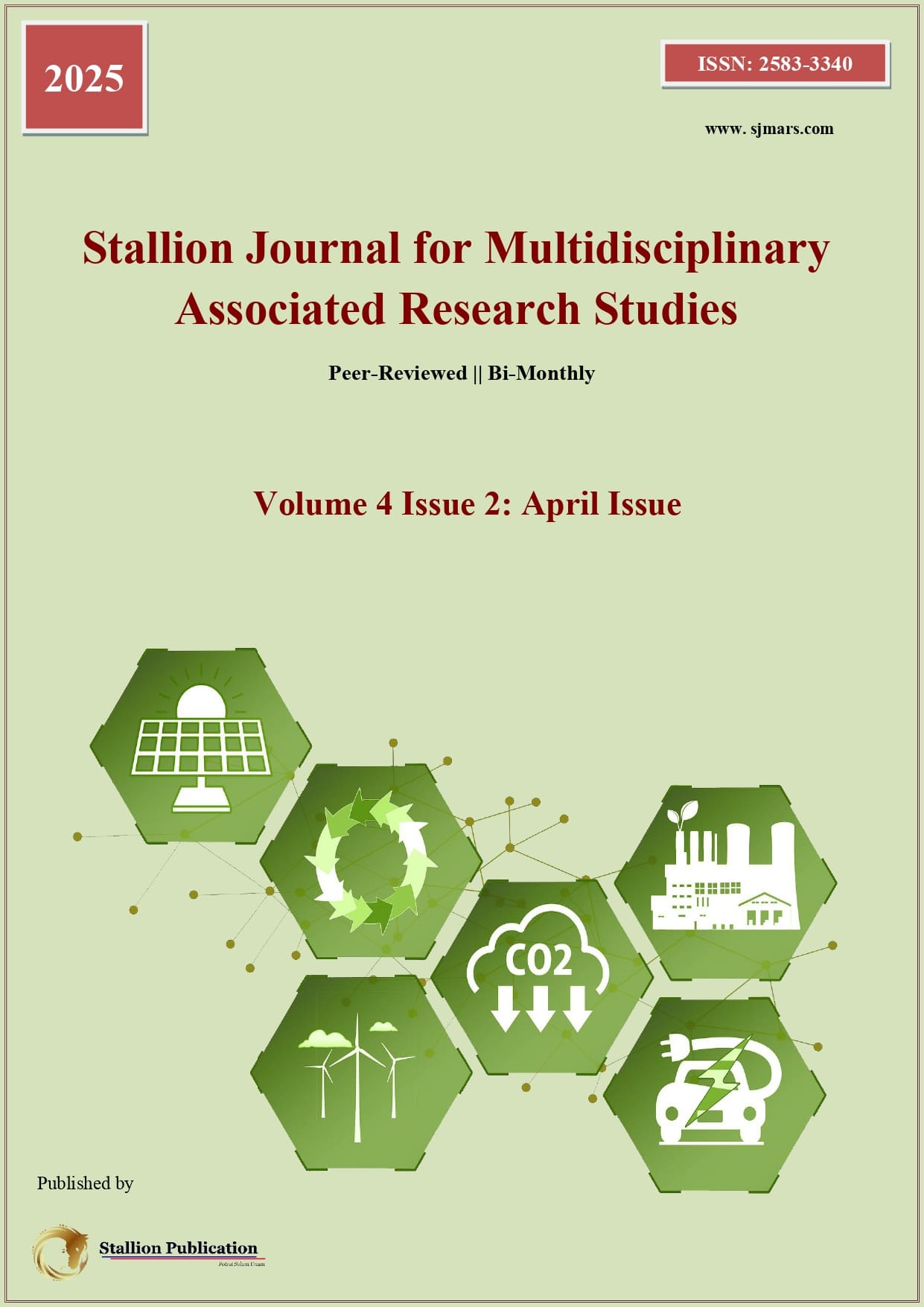Design and Optimization of Bilayered Semiconductor Thin Films for Efficient Solar-Driven Water Splitting
DOI:
https://doi.org/10.55544/sjmars.4.2.23Keywords:
Bilayered Semiconductor, , photoelectron-chemical (PEC), Solar-Driven Water SplittingAbstract
This research explores bilayer semiconductor thin films to improve photoelectrochemical water splitting, which presents a viable method for sustainable hydrogen production through solar energy. The focus is optimizing different semiconductor materials within a bilayer structure to enhance overall process efficiency. By carefully layering materials with complementary characteristics, the researchers intend to maximize light absorption over a wider spectrum, promote effective charge separation, and boost catalytic activity for splitting water. The performance of these improved bilayer thin films was assessed against single-layered versions. Results indicated a notable increase in photocurrent density, reflecting better light harvesting and charge carrier generation. Additionally, the bilayer structures showed enhanced stability, which is essential for long-term device functionality. Ultimately, the optimized bilayers demonstrated superior hydrogen evolution performance, leading to heightened hydrogen production efficiency. This strategy of employing bilayer thin films presents an encouraging pathway for developing more effective and stable photochemical water-splitting systems for sustainable hydrogen production.
References
[1] Abe, R., Sayama, K., & Sugihara, H. (2005). Development of new photocatalytic water splitting into H₂ and O₂ using two different semiconductor photocatalysts and a shuttle redox mediator IO⁻/I⁻. Journal of Physical Chemistry B, 109, 16052–16061. https://doi.org/10.1021/jp0511553
[2] Bard, A. J., & Fox, M. A. (1995). Artificial photosynthesis: Solar splitting of water to hydrogen and oxygen. Accounts of Chemical Research, 28(3), 141–145. https://doi.org/10.1021/ar00051a007
[3] Cesar, I., Kay, A., Martinez, J. A. G., & Grätzel, M. (2010). Translucent thin film Fe₂O₃ photoanodes for efficient water splitting by sunlight: Nanostructure-directing effect of Si-doping. Journal of the American Chemical Society, 132(20), 5858–5868. https://doi.org/10.1021/ja1010242
[4] Fujishima, A., & Honda, K. (1972). Electrochemical photolysis of water at a semiconductor electrode. Nature, 238, 37–38. https://doi.org/10.1038/238037a0
[5] Fujishima, A., Zhang, X., & Tryk, D. A. (2008). TiO₂ photocatalysis and related surface phenomena. Surface Science Reports, 63(12), 515–582. https://doi.org/10.1016/j.surfrep.2008.10.001
[6] Gao, H. W., Liu, C., Jeong, H. E., & Yang, P. D. (2012). Plasmon-enhanced photocatalytic activity of iron oxide on gold nanopillars. ACS Nano, 6(3), 234–240. https://doi.org/10.1021/nn204415w
[7] Iwase, A., Ng, Y. H., Ishiguro, Y., Kudo, A., & Amal, R. (2011). Reduced graphene oxide as a solid-state electron mediator in Z-scheme photocatalytic water splitting under visible light. Journal of the American Chemical Society, 133(29), 11054–11057. https://doi.org/10.1021/ja203088e
[8] Kato, H., Asakura, K., & Kudo, A. (2003). Highly efficient water splitting into H₂ and O₂ over lanthanum-doped NaTaO₃ photocatalysts with high crystallinity and surface nanostructure. Journal of the American Chemical Society, 125(10), 3082–3089. https://doi.org/10.1021/ja0213412
[9] Kato, H., Hori, M., Konta, R., Shimodaira, Y., & Kudo, A. (2004). Construction of Z-scheme type heterogeneous photocatalysis systems for water splitting into H₂ and O₂ under visible light irradiation. Chemical Letters, 33(10), 1348–1349. https://doi.org/10.1246/cl.2004.1348
[10] Khan, S. U. M., Al-Shahry, M., & Ingler, W. B. (2002). Efficient photochemical water splitting by a chemically modified n-TiO₂. Science, 297(5590), 2243–2245. https://doi.org/10.1126/science.1075035
[11] Kudo, A., & Miseki, Y. (2009). Heterogeneous photocatalyst materials for water splitting. Chemical Society Reviews, 38(1), 253–278. https://doi.org/10.1039/b800489g
[12] Maeda, K., Teramura, K., Lu, D. L., Takata, T., Saito, N., Inoue, Y., & Domen, K. (2006). Photocatalyst releasing hydrogen from water. Nature, 440(7082), 295. https://doi.org/10.1038/440295a
[13] Ohashi, K., McCann, J., & Bockris, J. O. M. (1977). Stable photoelectrochemical cells for the splitting of water. Nature, 266(5605), 610–611. https://doi.org/10.1038/266610a0
[14] Santato, C., Odziemkowski, M., Ulmann, M., & Augustynski, J. (2001). Crystallographically oriented mesoporous WO₃ films: Synthesis, characterization, and applications. Journal of the American Chemical Society, 123(43), 10639–10649. https://doi.org/10.1021/ja0166532
[15] Sasaki, Y., Nemoto, H., Saito, K., & Kudo, A. (2009). Solar water splitting using powdered photocatalysts driven by Z-schematic interparticle electron transfer without an electron mediator. Journal of Physical Chemistry C, 113(40), 17536–17542. https://doi.org/10.1021/jp905174w
[16] Sun, J. W., Liu, C., & Yang, P. D. (2011). Surfactant-free, large-scale, solution-liquid-solid growth of gallium phosphide nanowires and their use for visible-light-driven hydrogen production from water reduction. Journal of the American Chemical Society, 133(50), 19306–19309. https://doi.org/10.1021/ja207261m
[17] Yang, P. D., & Tarascon, J. M. (2012). Towards systems materials engineering. Nature Materials, 11(7), 560–563. https://doi.org/10.1038/nmat3340
[18] Zou, Z. G., Ye, J. H., Sayama, K., & Arakawa, H. (2001). Direct splitting of water under visible light irradiation with an oxide semiconductor photocatalyst. Nature, 414(6864), 625–627. https://doi.org/10.1038/414625a
Downloads
Published
How to Cite
Issue
Section
License
Copyright (c) 2025 Stallion Journal for Multidisciplinary Associated Research Studies

This work is licensed under a Creative Commons Attribution-NonCommercial-NoDerivatives 4.0 International License.






